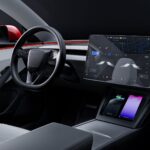The 2009 Chevrolet Corvette ZR1 marked a significant milestone in American automotive engineering, boldly asserting itself as a true supercar contender. This model wasn’t just an evolution of the Corvette lineage; it was a revolution, injecting cutting-edge technology and raw, supercharged power into the iconic sports car. Dubbed the “King of the Hill,” the 2009 Zr1 delivered a driving experience that could rival, and often surpass, European exotics, all while retaining Corvette’s signature accessibility and value.
Overview and Groundbreaking Specs
The 2009 ZR1 was built around a simple yet potent philosophy: maximum performance through advanced technology and meticulous engineering. At its heart lay the all-new LS9 supercharged 6.2L V-8 engine, a powerhouse designed to shatter performance benchmarks. Chevrolet aimed for a staggering output of at least 100 horsepower per liter, culminating in a targeted 638 horsepower (462 kW) and approximately 595 lb.-ft. of torque (823 Nm). These figures were not just numbers; they were a declaration of intent, positioning the ZR1 in the elite realm of supercars.
Key Specifications of the 2009 ZR1:
- Engine: All-new LS9 supercharged 6.2L V-8
- Horsepower: 638 hp (462 kW)
- Torque: 595 lb.-ft. (823 Nm)
- Transmission: Six-speed, close-ratio, race-hardened manual
- Clutch: High-capacity dual-disc
- Cornering Grip: Exceeds 1g
- Wheels: 20-spoke, 19-inch front and 20-inch rear
- Tires: Michelin Pilot Sport 2, P285/30ZR19 (front) and P335/25ZR20 (rear)
- Brakes: Standard carbon-ceramic, drilled disc rotors (15.5-inch front, 15-inch rear)
- Suspension: Standard Magnetic Selective Ride Control with track-level tuning
- Weight: Approximately 3,350 pounds (1,519 kg)
- Top Speed: Targeted to exceed 200 mph
These specifications underscored the ZR1’s commitment to performance. The supercharged engine, coupled with a robust drivetrain and advanced chassis components, promised an unparalleled driving experience. Chevrolet emphasized that the ZR1 was not just about brute force, but about refined power and exceptional driveability, challenging the notion that supercars had to be temperamental or impractical.

The 2009 Corvette ZR1 showcasing its aggressive stance and carbon fiber elements.
The Heart of the Beast: Supercharged LS9 Engine
The LS9 6.2L small-block engine was purpose-built to be the powerhouse of the ZR1. Its supercharged induction system was the key to unlocking its immense performance. At the core of this system was a large, positive-displacement Roots-type supercharger developed by Eaton, featuring a novel four-lobe rotor design. This advanced supercharger was integrated with a charge cooling system, crucial for reducing the temperature of the intake air and maximizing engine efficiency and power output.
The sixth-generation Eaton supercharger was instrumental in delivering both massive horsepower and torque across a broad RPM range. Unlike some supercharged engines where performance tapers off at higher RPMs, the LS9 was engineered to maintain power delivery all the way to its 6,600 RPM redline. This was achieved through a combination of the efficient supercharger design and high-quality, lightweight engine components.
LS9 Engine Highlights:
- Hand-Assembled: Built at GM’s Performance Build Center in Wixom, Michigan, ensuring precision and quality.
- Rotocast Cylinder Heads: Premium A356T6 alloy heads, rotocast for enhanced strength and heat resistance.
- Titanium Connecting Rods: Lightweight and durable for high-RPM operation.
- Forged Aluminum Pistons: Optimized for strength and reduced weight.
- Dry-Sump Oiling System: Ensures consistent lubrication under high-G cornering.
- Dual Pressure Fuel System: Adapts fuel pressure for optimal performance across driving conditions.
The LS9 engine wasn’t just a collection of high-performance parts; it was a meticulously crafted piece of engineering. The hand-assembly process, combined with specialized techniques borrowed from racing engine construction, resulted in an engine that was both incredibly powerful and surprisingly refined. The use of a deck plate during cylinder honing, for example, ensured superior cylinder sealing and overall engine performance.

A detailed view of the LS9 supercharged engine, the heart of the 2009 Corvette ZR1.
Transmission and Drivetrain Enhancements
To effectively handle the LS9’s prodigious power, the 2009 ZR1 featured a new, heavy-duty six-speed manual transmission from Tremec, the TR6060. This transmission was specifically upgraded for the ZR1 to withstand the engine’s high torque output while providing improved shift quality. A key component was the twin-disc clutch system, designed to offer exceptional clamping force without sacrificing pedal feel.
The twin-disc clutch utilized two smaller 260-mm discs, distributing the engine’s torque load over a larger area. This resulted in increased clamping power, better heat dissipation, and extended clutch life, even under demanding driving conditions. Despite its enhanced capability, the twin-disc system maintained a clutch pedal effort similar to the Corvette Z06, ensuring a comfortable driving experience.
Drivetrain Upgrades:
- Tremec TR6060 Six-Speed Manual: Race-hardened and close-ratio for optimal performance.
- Twin-Disc Clutch: Enhanced clamping force, heat dissipation, and clutch life.
- ZR1-Specific Gearing: Steeper first gear for launch and top speed achieved in sixth gear.
- Stronger Rear Axle: Asymmetrical axle-shaft diameters for optimal torque management.
The ZR1’s drivetrain was engineered to translate the LS9’s power into blistering performance. The close-ratio gearbox, coupled with the robust clutch and axle components, ensured that every ounce of horsepower and torque was efficiently delivered to the wheels, resulting in rapid acceleration and a thrilling driving experience.
Ride, Handling, and Braking Prowess
The 2009 ZR1 built upon the already impressive chassis of the Corvette Z06, utilizing a lightweight aluminum frame and independent SLA front and rear suspensions with aluminum control arms. However, the ZR1’s suspension was uniquely tuned to complement its wider tires and enhanced performance capabilities. Standard Magnetic Selective Ride Control (MSRC) played a crucial role in balancing ride comfort and handling precision.
MSRC allowed for near-instantaneous adjustments to damping forces, adapting to road conditions and driving style in milliseconds. This technology enabled engineers to achieve a surprisingly compliant ride quality in a supercar capable of exceeding 1g of cornering grip. MSRC also contributed to improved launch performance by minimizing axle hop and enhancing stability during hard cornering on uneven surfaces.
Chassis and Handling Features:
- Aluminum-Intensive Chassis: Lightweight and stiff for optimal handling.
- Magnetic Selective Ride Control (MSRC): Adaptive damping for superior ride and handling balance.
- ZR1-Specific Suspension Tuning: Optimized for wider tires and increased performance.
- Michelin Pilot Sport 2 Tires: Developed specifically for the ZR1, providing exceptional grip.
- Carbon-Ceramic Brakes: Lightweight, heat-resistant, and fade-free braking performance.
The braking system of the 2009 ZR1 was as impressive as its engine. Standard carbon-ceramic brake rotors, a technology typically reserved for high-end exotics, provided immense stopping power with minimal weight. These rotors were not only larger than those on the Z06 (15.5-inch front and 15-inch rear) but also offered exceptional resistance to heat and wear, virtually eliminating brake fade even under extreme conditions. Large six-piston front and four-piston rear calipers, painted in ZR1-exclusive blue, clamped down on these rotors, ensuring confident and consistent braking performance.

The 2009 ZR1’s carbon ceramic brakes and distinctive blue calipers, showcasing its high-performance braking system.
Exclusive Exterior and Interior Design
The 2009 ZR1 distinguished itself visually with a range of unique exterior elements, most notably its raised, all-carbon-fiber hood featuring a clear polycarbonate window. This window provided a direct view of the LS9’s supercharger intercooler, boldly displaying the “LS9 SUPERCHARGED” legend. Exposed carbon-fiber was also used for the roof, roof bow, rocker moldings, and front splitter, adding to the ZR1’s exotic appeal and reducing weight.
Wider carbon-fiber front fenders with dual vents, and a ZR1-specific rear spoiler further enhanced the car’s aerodynamic profile and aggressive stance. These design elements weren’t just for show; they were functional, contributing to high-speed stability and driver control.
Exterior Distinguishing Features:
- Carbon-Fiber Hood with Polycarbonate Window: Showcases the supercharged engine.
- Exposed Carbon-Fiber Elements: Roof, roof bow, rocker moldings, front splitter.
- Wider Carbon-Fiber Front Fenders: With ZR1-specific dual vents.
- ZR1-Specific Rear Spoiler: Enhanced aerodynamics.
- 20-Spoke Alloy Wheels: 19-inch front and 20-inch rear, ZR1 exclusive design.
Inside, the ZR1’s interior built upon the Corvette’s dual-cockpit design, incorporating premium materials and ZR1-specific details. These included ZR1 logos on the sill plates and headrest embroidery, a unique gauge cluster with a 220-mph speedometer and boost gauge, and optional leather-wrapped interior in multiple colors. The ZR1 offered a blend of track-focused functionality and upscale comfort.
Interior ZR1 Enhancements:
- ZR1-Logo Sill Plates and Headrest Embroidery.
- Specific Gauge Cluster: With ZR1 logo, 220-mph speedometer, and boost gauge.
- Optional Leather-Wrapped Interior: Available in four colors.
- Luxury Package Option: Including power-adjustable leather sport seats, navigation, and Bluetooth.

The distinct carbon fiber hood with polycarbonate window, a signature design element of the 2009 Corvette ZR1.
By the Numbers: Exclusivity and Performance Metrics
The 2009 ZR1 was not just a high-performance Corvette; it was a limited-production halo car. Each ZR1 was uniquely identified by its Vehicle Identification Number (VIN), featuring a specific digit and a sequential build number. This system allowed enthusiasts and collectors to easily determine the production order of their ZR1, adding to its exclusivity and collectability.
2009 Corvette ZR1 Preliminary Specifications Highlights:
- Horsepower: 638 hp (475 kW)
- Torque: 604 lb-ft (835 Nm)
- Displacement: 6.2L / 376 cu in
- Curb Weight: 3350 lb (1519 kg)
- Wheelbase: 105.7 in (2685 mm)
These specifications solidified the ZR1’s position as a performance leader. Its power-to-weight ratio surpassed competitors like the Porsche 911 GT2 and Lamborghini LP640, underscoring its exceptional engineering and performance capabilities. The targeted top speed of over 200 mph further emphasized its status as a true supercar.
The Supercharged LS9 V-8: Powering the Ultimate Corvette
The announcement of the 2009 Corvette ZR1 was intrinsically linked to its groundbreaking engine: the supercharged LS9 small-block V-8. GM Powertrain aimed to achieve 100 horsepower per liter with this engine, resulting in the targeted 620 horsepower (later finalized at 638 hp) and approximately 595 lb.-ft. of torque. The LS9 represented the pinnacle of small-block engine technology for General Motors, designed to deliver both exhilarating performance and surprising refinement.
Tom Stephens, group vice president for GM Powertrain and Quality, described the LS9 as redefining “performance and refinement,” highlighting its smooth low-speed driveability alongside its fierce high-end power. The Eaton supercharger and integrated charge cooling system were crucial in achieving this balance, providing instant power and sustained performance across the RPM range.
LS9 Engine Performance Range:
- 300 hp (224 kW) at 3,000 rpm (approx.)
- 320 lb.-ft. of torque (434 Nm) at 1,000 rpm (approx.)
- Peak Torque over 585 lb.-ft. (793 Nm) around 4,000 rpm
- Peak Horsepower at 6,500 rpm
- 90% of Peak Torque from 2,600 rpm to 6,000 rpm
The LS9’s broad powerband made it exceptionally responsive and tractable in various driving conditions, from everyday cruising to track-day assaults. The engine’s robust construction, including forged internal components and rotocast cylinder heads, ensured durability and reliability under extreme stress.
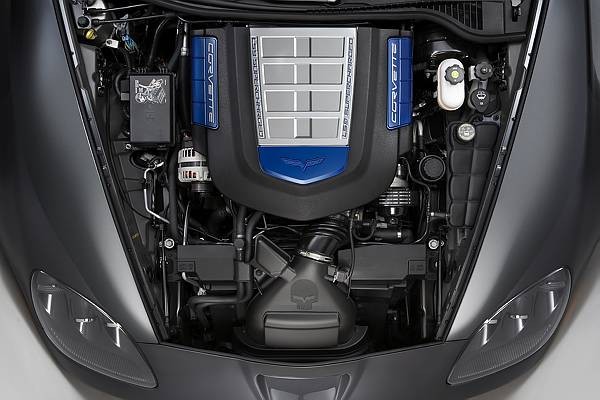
Close-up view of the LS9 supercharger, showcasing its intricate design and the “LS9 SUPERCHARGED” legend.
Chassis and Suspension: More Than Just Raw Power
While the LS9 engine was undoubtedly the star of the show, the 2009 ZR1’s chassis and suspension were equally critical to its overall performance. Engineers focused on creating a balanced driving experience that combined supercar-level performance with everyday usability. Tom Wallace, vehicle line executive, emphasized that “refinement, balance, and compliance” were as important as outright performance targets.
The ZR1 retained the lightweight aluminum structure of the Z06 but incorporated specific chassis and suspension tuning to optimize handling and ride quality. Standard Magnetic Selective Ride Control (MSRC) and specially developed Michelin Pilot Sport 2 tires were key enablers in achieving this balance. Tadge Juechter, Corvette chief engineer, noted that the ZR1’s handling built upon the Z06’s capabilities but offered ride compliance closer to the base Corvette coupe.
Chassis and Suspension Highlights:
- Lightweight Aluminum Structure.
- Magnetic Selective Ride Control (MSRC) tuned for ZR1.
- Specific Spring and Stabilizer Bar Rates.
- Michelin Pilot Sport 2 Tires engineered for ZR1.
- Carbon-Ceramic Brakes for reduced unsprung mass.
The ZR1’s chassis was designed for optimal stiffness and low mass, utilizing hydroformed aluminum frame rails and advanced structural composites. The magnesium engine cradle further contributed to weight distribution and handling balance. The suspension tuning, coupled with MSRC, allowed for a surprisingly comfortable ride without compromising cornering prowess.
Carbon-Ceramic Brakes and Michelin Pilot Sport 2 Tires
The carbon-ceramic brake system of the 2009 ZR1 was a technological marvel. These rotors offered significant weight savings compared to iron rotors, reducing unsprung mass and improving handling agility. Their exceptional heat resistance and wear characteristics ensured consistent braking performance even under extreme track conditions. The large rotors and calipers provided phenomenal stopping power, matching the ZR1’s breathtaking acceleration.
Michelin Pilot Sport 2 tires, developed specifically for the ZR1, were another crucial element of its performance. Michelin engineers worked closely with GM to tailor these tires to the ZR1’s unique performance requirements, considering factors like horsepower, weight, aerodynamics, and top speed. The resulting tires offered exceptional grip and handling, contributing to the ZR1’s impressive cornering capabilities and overall driving dynamics. Run-flat technology eliminated the need for a spare tire, further saving weight.
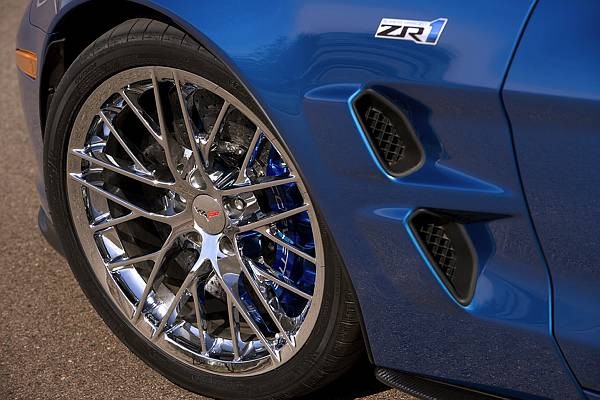
A detailed view of the Michelin Pilot Sport 2 tire and 20-spoke wheel, components specifically engineered for the 2009 ZR1.
Performance-Driven Design: Form Follows Function
The design of the 2009 ZR1 was inherently performance-driven. While aesthetically striking, every exterior element served a functional purpose, contributing to aerodynamics, cooling, or weight reduction. Kirk Bennion, exterior design manager, stated that the ZR1’s design was “performance-driven” and “not shy about its capability.”
The exposed carbon-fiber elements, windowed hood, widened fenders, and rear spoiler all played a role in enhancing the ZR1’s high-speed stability and handling. The front splitter and rear spoiler were carefully shaped and wind-tunnel tested to generate increased downforce compared to the Z06. Even the front fender vents and suspension A-arms were designed with aerodynamics in mind, channeling airflow for cooling and reduced drag.
Design Features and Functionality:
- Carbon-Fiber Components: Weight reduction and exotic appearance.
- Widened Front Fenders with Vents: Accommodation of wider tires and heat extraction.
- Front Splitter and Rear Spoiler: Increased downforce for high-speed stability.
- Functional Brake Cooling Ducts: Enhanced brake performance.
- Aerodynamically Optimized Suspension Components.
The ZR1’s design was a masterful blend of form and function, creating a visually stunning car that was also aerodynamically efficient and performance-optimized. The use of exposed carbon-fiber not only saved weight but also added to the ZR1’s exclusive and high-tech persona.
Interior Refinements: A Driver-Focused Cockpit
The interior of the 2009 ZR1 maintained the Corvette’s driver-centric layout while incorporating unique ZR1 touches and premium materials. The dual-cockpit design provided an intimate and focused driving environment. ZR1-specific logos, gauge cluster, and optional leather trim elevated the cabin’s ambiance, reflecting the car’s performance pedigree and premium status.
The “base” ZR1 (1LZ trim) offered a lightweight, track-focused interior, while the uplevel package provided enhanced comfort and luxury features, including power-adjustable leather sport seats, navigation, and Bluetooth connectivity. Regardless of trim level, the ZR1’s interior was designed to support high-performance driving while offering a comfortable and refined experience.
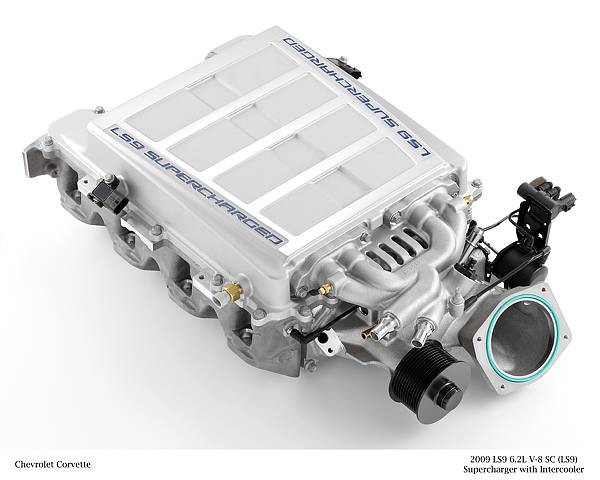
The 2009 ZR1 interior, highlighting the ZR1-specific gauge cluster and driver-focused cockpit.
Corvette ZR1: Reigning as the King Once Again
The 2009 ZR1 marked the return of a legendary nameplate, resurrecting the “King of the Hill” moniker from the early 1990s. The original ZR-1 (1990-1995) had caused a sensation with its advanced LT5 DOHC V-8 engine and groundbreaking performance. The 2009 ZR1 aimed to recapture that magic, delivering a new level of performance and technology for the Corvette.
While the standard 2008 Corvette already boasted impressive horsepower, the 2009 ZR1’s supercharged LS9 engine elevated performance to a new stratosphere. The ZR1 offered a similar performance advantage over the base Corvette as the original ZR-1 did in its era, reaffirming its position as the ultimate Corvette. Notably, the 2009 ZR1 was designated as “ZR1” without the hyphen of its predecessor, reflecting a change in GM’s naming conventions.
2009 Corvette RPO CSC: The Competition Sport Package
For enthusiasts seeking an even more track-focused Corvette, Chevrolet offered the Competition Sport Package (RPO CSC) for the 2009 Corvette Coupe and Z06 models. This limited-edition package was inspired by the National Corvette Museum’s HPDE events and aimed at drivers who participated in track days and autocross.
The Competition Sport Package included unique aesthetic and functional enhancements, such as Competition Gray exterior accents, Corvette Racing “Jake” and CSR logos, ebony interior with titanium embroidery, Corvette racing pedals, and a special engine cover. The package focused on lightweight components and track-oriented features, creating a ready-to-race Corvette straight from the factory.
Competition Sport Package Highlights:
- Competition Gray Exterior Stripes, Wheels, and Headlamps.
- Corvette Racing “Jake” and CSR Logos.
- Ebony Interior with Titanium Embroidery.
- Corvette Racing Pedals.
- Special Engine Cover.
- Racing-Style Numbers (customer installable).
- Z51 Performance Package, NPP Exhaust, Differential Cooler (Coupe).
- Head-Up Display (Coupe).
- Z06 Tall Spoiler (Coupe).
The Competition Sport Package was available on both Coupe and Z06 models in limited quantities and specific color combinations. It represented a further step in catering to Corvette enthusiasts who demanded the ultimate in track performance and exclusivity.
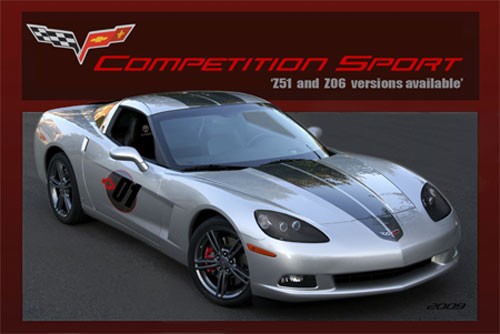
The 2009 Corvette Competition Sport Package, showcasing its unique stripes, wheels, and racing-inspired details.
Conclusion: The 2009 ZR1 – A Supercar Icon
The 2009 Corvette ZR1 was more than just a car; it was a statement. It demonstrated that American engineering could compete with the best supercars in the world, offering comparable, and in some cases, superior performance at a more accessible price point. The ZR1’s combination of raw supercharged power, advanced technology, and refined driving dynamics cemented its place as a true icon in automotive history. It was, and remains, a testament to Chevrolet’s commitment to pushing the boundaries of performance and innovation, solidifying the Corvette’s legacy as America’s premier sports car. The 2009 ZR1 truly earned its title as the “King of the Hill,” setting a new benchmark for American supercars and captivating enthusiasts worldwide.
